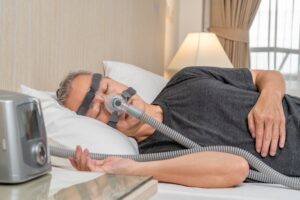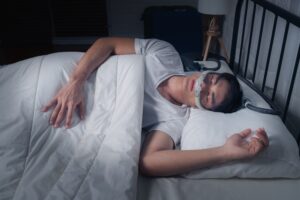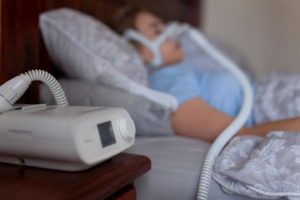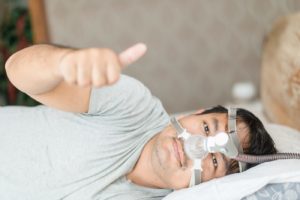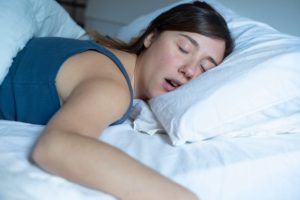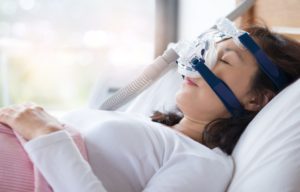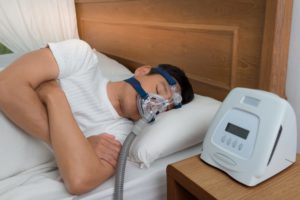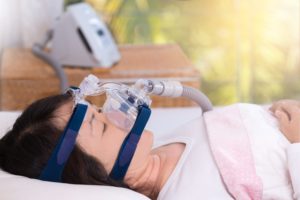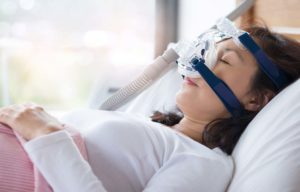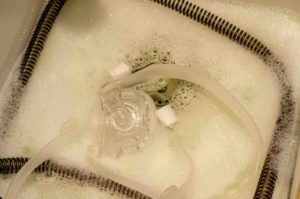When you buy through our links, we may earn a commission. Products or services may be offered by an affiliated entity. Learn more.
Does Insurance Cover CPAP?
If you’ve been diagnosed with obstructive sleep apnea, your doctor may have prescribed you a continuous positive airway pressure (CPAP) machine to help you sleep better. And while CPAP therapy is effective, it can also be expensive. Typical CPAP device prices range from $250 to $1,000 or more, not including the cost of necessary accessories such as filters and masks.
We’ll cover some of the most common insurance policies surrounding CPAP equipment. These policies may be updated from time to time, so always check with your insurance provider for the most up-to-date information. You can see our recommended suppliers that take insurance for CPAP here.
Will My Insurance Cover CPAP Equipment?
Most insurance plans partially cover the costs of CPAP machines and related equipment. Often, the machines themselves are covered to an extent, but you may be responsible for other components such as tubing. Sometimes replacement parts are covered, with a limit to how many replacement parts can be purchased annually. Many insurance providers require you to meet your annual deductible before covering your CPAP equipment.
Insurance providers typically take your apnea-hypopnea index (AHI) into consideration when determining your eligibility for CPAP therapy coverage. Your AHI is the average number of partial or complete breathing cessation events you experience per hour. To determine your AHI, you must undergo a sleep study in a sleep lab or do an at-home sleep test.
Sleep apnea is classified as mild, moderate, or severe, depending on the AHI reading. An AHI between 5 and 15 is considered mild, an AHI between 15 and 30 is moderate, and an AHI greater than 30 is severe. Medicaid and Medicare partially cover CPAP machines for all three AHI indexes, provided you meet certain conditions. Other insurance providers may have different standards. Be sure to check your insurance policy to determine your specific requirements.
Insurance Compliance and Prescription Requirements
Before most insurance providers will pay for your CPAP equipment, you must fulfill two requirements. First, you must have a prescription for CPAP therapy from your healthcare provider. Second, you must successfully complete a compliance period with the CPAP machine, to demonstrate that you are using the treatment regularly.
In order to give you a prescription for a CPAP machine, your doctor must confirm that your sleep difficulties are caused by sleep apnea and not by another condition. Your doctor will first check for symptoms of obstructive sleep apnea, including:
- Loud snoring throughout the night
- Gasping or snorting during sleep
- Excessive daytime sleepiness
- Forgetfulness
- Headaches
- Drowsiness or falling asleep while driving
If your symptoms indicate you might have obstructive sleep apnea, the next step is to take a sleep study. Doctors can test for sleep apnea with an overnight in-lab sleep study, also called a polysomnography, or with an at-home sleep study. After reading and interpreting the results of your sleep study, your doctor may diagnose you with sleep apnea and work with you to develop a treatment plan.
In order to be eligible for reimbursement, the Centers for Medicaid and Medicare (CMS) require proof that you are using the CPAP machine at least four hours per night, on 70% of nights, in a consecutive 30-day period. Most machines record your use for you. Some machines connect to an app on your phone and transmit usage information, while others use an SD card reader to collect the data. If you’re unable to meet these requirements during the first 3 months, you may have to start the process again.
While these are the most common prescription and compliance requirements for CPAP coverage, each provider has its own specific rules. Review your policy to learn about the requirements specific to your insurance provider.
Insurance and CPAP Machines
Your insurance coverage for a CPAP machine depends on your provider. Some providers reimburse you for the cost of purchasing the machine outright, while others require a rent-to-own plan under which you must use the machine for a set amount of time before it becomes your property.
Costs for purchasing a machine outright can range anywhere from $250 to $1,000 or more, depending on where you live and the type of machine you need. Most CPAP machines cost between $500 and $800. BiPAP machines, which provide a different level of air pressure for exhalation and inhalation, frequently run in the thousands of dollars.
If you are on a rent-to-own structure, your monthly fee typically equals the cost of the CPAP machine divided by the number of rental months. Your insurance provider usually splits this cost with you, and the exact amount you pay depends on your policy. Bear in mind that if you are required to rent for longer than a year, you may need to pay a second deductible.
If your insurance company determines you are not using the machine frequently enough as per your policy, they may stop covering their portion of the machine rental. You must decide if you prefer to pay the full cost of the monthly rental, purchase the machine outright, or stop CPAP treatment.
Be aware that if you decide to stop CPAP treatment and decide later that you want to try the treatment again, your insurance company may require you to re-qualify for coverage. This process involves performing another sleep study to receive a new diagnosis of sleep apnea and another prescription for a CPAP machine. The necessary doctor’s appointments and sleep studies come with their own costs, depending on your insurance plan and associated deductible.
If this all sounds overwhelming, CPAPinsurance.com can help simplify the process. The site walks you through your options and connects you with recommended providers so you can get your CPAP machine and supplies through insurance — without the guesswork.
Insurance and CPAP Supplies
When beginning CPAP treatment, the biggest upfront cost is the CPAP machine itself. Then there are supplies that need to be replaced over time, including:
- Masks
- Mask components
- Tubing
- Filters
- Chin straps
- Headgear
- Water chamber
The costs for each component vary. Filters, which need to be replaced frequently, run between $5 and $30 each. Masks often cost $100 or more, and other equipment ranges between $20 and $100. Some rental plans may include the cost of replacement equipment, which is something to bear in mind when comparing the cost of buying outright versus going with insurance.
Many insurance providers use the Medicare guidelines for replacing equipment:
| Item Description | Frequency |
|---|---|
| Combination Oral/Nasal CPAP Mask | Every 3 months |
| Full Face Mask | Every 3 months |
| Chinstrap | Every 6 months |
| Tubing | Every 3 months |
| Headgear | Every 6 months |
| Disposable Filter | Twice per month |
| Nondisposable Filter | Every 6 months |
| Humidifier Water Chamber | Every 6 months |
However, each provider has its own replacement guidelines. Among state Medicaid programs, 51% adhere to these guidelines, but 39% allow for less frequent replacement of CPAP equipment. Only 10% allow for more frequent replacement.
Insurance and CPAP Accessories
As you adjust to CPAP treatment, you may want additional accessories for more comfortable sleep and easier travel. There are a number of optional accessories you can purchase for your CPAP machine. These include:
- CPAP pillows are cut to accommodate the machine and tubing and allow you to move during the night.
- CPAP cleaners may help disinfect your machine and extend its longevity.
- Mask liners can wick away moisture and ensure a tighter seal to keep the mask in place.
- Hose holders help the CPAP machine feel softer against the body and look less medical in appearance.
- CPAP batteries are convenient for travel when you don’t have access to a power outlet.
- Travel bags can hold all your CPAP equipment when you’re on the go.
Insurance does not typically cover any products that are considered optional. Costs for these products can vary depending on the quality. More expensive accessories often come with warranties of one to three years.
Does Medicare Cover CPAP?
Medicare considers CPAP devices to be durable medical equipment and provides 80% coverage under Part B as long as you meet certain conditions. First, your doctor must diagnose you with obstructive sleep apnea following an approved laboratory sleep study or an at-home sleep study and give you a prescription for a CPAP machine.
Then, Medicare covers a 12-week initial period of CPAP therapy for obstructive sleep apnea, as long as you meet the following requirements:
- You have an hourly AHI between 5 and 14 and a comorbid condition related to obstructive sleep apnea, including hypertension, history of stroke, heart disease, excessive daytime sleepiness, insomnia, mood disorders, and impaired cognition; or
- You have an hourly AHI of 15 or higher.
You must also meet Medicare’s compliance requirements, which state that you must use the machine at least four hours per night, 70% of the time or more, during the first three months. If you fail to meet these requirements, you have to begin the process again. This involves completing another sleep study, either in a lab or at home, and obtaining another prescription from your doctor.
If the CPAP therapy helps improve your sleep apnea symptoms during the 12-week period, Medicare continues to cover the cost of your CPAP equipment. With Original Medicare coverage, you pay 20% of the machine rental plus the cost of supplies such as the CPAP mask and tubing. Once you meet your Medicare Plan B deductible, Medicare pays for the rental of the machine for 13 months if you use it continually. After 13 months, you own the machine.
Does Medicaid Cover CPAP?
State Medicaid programs typically follow the same guidelines as Medicare. You need a sleep test, diagnosis of obstructive sleep apnea, and prescription from your doctor. Your AHI must also meet the same requirements as for Medicare:
- AHI index between 5 and 14, along with a comorbidity related to obstructive sleep apnea; or
- AHI of at least 15.
If you meet these requirements, then Medicaid provides CPAP coverage for a 12-week trial. Coverage continues if your sleep apnea improves with the CPAP treatment. You must also adhere to the same compliance requirements as Medicare recipients, namely using the machine at least four hours every night on 70% of nights.
Paying Out-of-Pocket For CPAP Equipment
Insurance plans can significantly help with the cost of a CPAP machine. However, if your plan has a high deductible, you might be tempted to purchase your CPAP equipment on your own and bypass your insurance. You might be able to find direct-to-supplier CPAP manufacturers with lower prices than those available through your insurance plan, though be sure to check if these devices are approved by the FDA.
When making your decision, calculate whether your CPAP equipment is likely to cost more than your deductible, both now and in the long run. Don’t forget to budget the ongoing costs of tubes, filters, and other replacements.
Keep in mind that whether or not you use insurance, medical equipment sellers require a CPAP prescription in order for you to purchase the machine and equipment. This means your doctor still needs to conduct a sleep study to give you a diagnosis. Once you have the prescription, you can choose whether to buy your CPAP equipment outright or go through your insurance plan.

When you choose to buy your CPAP equipment without insurance, you can skip the rent-to-own process and own your machine right away. You also avoid the insurance requirements of treatment compliance. This eliminates the possibility of needing to return your machine and restart the process of getting a sleep test and prescription from your doctor.
Another benefit to paying a medical equipment supplier directly is the wider choice of products available to you. When purchasing with an insurance provider, you’re restricted to the suppliers that are covered by your insurance. This limits your options, and you may not get the exact product you want. Paying for your equipment directly gives you the opportunity to compare products and choose the CPAP equipment you find most suitable.
Frequently Asked Questions
How often does insurance cover CPAP machines?
Most insurance plans offer partial coverage for CPAP machines once you meet your deductible. Medicare participants are responsible for paying their deductible, plus 20% of the machine rental. If you have a high deductible under your health insurance policy, you may inadvertently end up covering the full cost of your CPAP machine.
How much will I pay for CPAP equipment?
CPAP machine prices start around $250 and can reach $1,000 or higher. More advanced machines tend to cost more. How much you pay depends on your insurance coverage. You’ll also need to pay for additional equipment such as filters, which run between $5 and $30, and masks, which can cost up to $100. Most other equipment ranges between $20 and $100.
Does my deductible apply to CPAP equipment?
Typically, your deductible applies to essential CPAP equipment and doesn’t include optional accessories. Most providers have replacement schedules for components such as tubes, masks, and filters that indicate how often replacements are covered. If you require more frequent replacements of certain components, those costs may be out of pocket.
Will insurance pay for sleep apnea sleep studies?
Most insurance plans cover a portion of the cost of your sleep studies, including studies conducted in a sleep lab or at home. Typically, you need a referral for a sleep study in order to receive coverage. Your doctor must determine which type of study is right for you.

Still have questions? Ask our community!
Join our Sleep Care Community — a trusted hub of product specialists, sleep health professionals, and people just like you. Whether you’re searching for the perfect mattress or need expert sleep advice, we’ve got you covered. Get personalized guidance from the experts who know sleep best.






